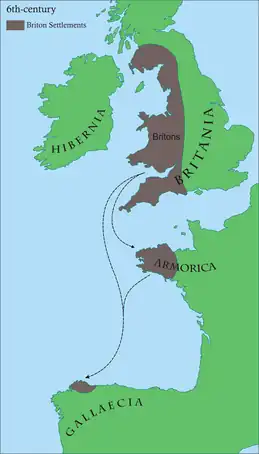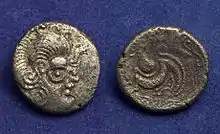Armorica
In ancient times, Armorica or Aremorica (Gaulish: Aremorica; Breton: Arvorig [arˈvoːrik]; French: Armorique [aʁmɔʁik]) was a region of Gaul between the Seine and the Loire that includes the Brittany Peninsula, extending inland to an indeterminate point and down the Atlantic Coast.[1]

Name
The name Armorica is a Latinized form of the Gaulish toponym Aremorica, which literally means 'place in front of the sea'. It is formed with the prefix are- ('in front of') attached to -mori- ('sea') and the feminine suffix -(i)cā, denoting the localization (or provenance). The inhabitants of the region were called Aremorici (sing. Aremoricos), formed with the stem are-mori- extended by the determinative suffix -cos. It is glossed by the Latin antemarini in Endlicher's Glossary. The Slavs use a similar formation, Po-mor-jane ('those in front of the sea'), to designate the inhabitants of Pomerania.[2] The Latin adjective Armoricani was an administrative term designating in particular a sector of the Roman defence line in Gaul in Late Antiquity, the Tractus Armoricani ('Armorican Tract').[3][4]
In medieval Insular Celtic languages, the Celtic term *Litauia, meaning 'Land' or 'Country' (from an original Proto-Celtic *Litauī 'Earth', lit. 'the Vast One'), came to be used to designate the Brittany Peninsula, as in Old Irish Letha, Old Welsh Litau, Old Breton Letau, or in the Latinized form Letavia.[5]
In Breton, which belongs to the Brythonic branch of the Insular Celtic languages, along with Welsh and Cornish, "on [the] sea" is war vor (Welsh ar fôr, "f" being voiced and pronounced like English "v"), but the older form arvor is used to refer to the coastal regions of Brittany, in contrast to argoad (ar "on/at", coad "forest" [Welsh ar goed or coed "trees"]) for the inland regions.[6] The cognate modern usages suggest that the Romans first contacted coastal people in the inland region and assumed that the regional name Aremorica referred to the whole area, both coastal and inland.
History

Pliny the Elder, in his Natural History (4.17.105), claims that Armorica was the older name for Aquitania and states Armorica's southern boundary extended to the Pyrenees. Taking into account the Gaulish origin of the name, that is perfectly correct and logical, as Aremorica is not a country name but a word that describes a type of geographical region, one that is by the sea. Pliny lists the following Celtic tribes as living in the area: the Aedui and Carnuteni as having treaties with Rome; the Meldi and Secusiani as having some measure of independence; and the Boii, Senones, Aulerci (both the Eburovices and Cenomani), the Parisii, Tricasses, Andicavi, Viducasses, Bodiocasses, Veneti, Coriosvelites, Diablinti, Rhedones, Turones, and the Atseui.
Trade between Armorica and Britain, described by Diodorus Siculus and implied by Pliny[7] was long-established. Because, even after the campaign of Publius Crassus in 56 BC, continued resistance to Roman rule in Armorica was still being supported by Celtic aristocrats in Britain. Julius Caesar led two invasions of Britain, in 55 BC, and again in 54 BC, in response. Some hint of the complicated cultural web that bound Armorica and the Britanniae (the "Britains" of Pliny) is given by Caesar when he describes Diviciacus of the Suessiones as "the most powerful ruler in the whole of Gaul, who had control not only over a large area of this region but also of Britain"[8] Archaeological sites along the south coast of England, notably at Hengistbury Head, show connections with Armorica as far east as the Solent. This 'prehistoric' connection of Cornwall and Brittany set the stage for the link that continued into the medieval era. Still farther East, however, the typical Continental connections of the Britannic coast were with the lower Seine valley instead.

Archaeology has not yet been as enlightening in Iron-Age Armorica as the coinage, which has been surveyed by Philip de Jersey.[9]
Under the Roman Empire, Armorica was administered as part of the province of Gallia Lugdunensis, which had its capital in Lugdunum, (modern day Lyon). When the Roman provinces were reorganized in the 4th century, Armorica (Tractus Armoricanus et Nervicanus) was placed under the second and third divisions of Lugdunensis. After the legions retreated from Britannia (407 AD) the local elite there expelled the civilian magistrates in the following year; Armorica too rebelled in the 430s and again in the 440s, throwing out the ruling officials, as the Romano-Britons had done. At the Battle of the Catalaunian Plains in 451 a Roman coalition led by General Flavius Aetius and the Visigothic King Theodoric I clashed violently with the Hunnic alliance commanded by King Attila the Hun. Jordanes lists Aëtius' allies as including Armoricans and other Celtic or German tribes (Getica 36.191).
The "Armorican" peninsula came to be settled with Britons from Britain during the poorly documented period of the 5th–7th centuries.[10] Even in distant Byzantium Procopius heard tales of migrations to the Frankish mainland from the island, largely legendary for him, of Brittia.[11] These settlers, whether refugees or not, made the presence felt of their coherent groups in the naming of the westernmost, Atlantic-facing provinces of Armorica, Cornouaille ("Cornwall") and Domnonea ("Devon").[12] These settlements are associated with leaders like Saints Samson of Dol and Pol Aurelian, among the "founder saints" of Brittany.
The linguistic origins of Breton are clear: it is a Brythonic language descended from the Celtic British language, like Welsh and Cornish one of the Insular Celtic languages, brought by these migrating Britons. Still, questions of the relations between the Celtic cultures of Britain— Cornish and Welsh—and Celtic Breton are far from settled. Martin Henig (2003) suggests that in Armorica as in sub-Roman Britain:
There was a fair amount of creation of identity in the migration period. We know that the mixed, but largely British and Frankish population of Kent repackaged themselves as 'Jutes', and the largely British populations in the lands east of Dumnonia (Devon and Cornwall) seem to have ended up as 'West Saxons'. In western Armorica, the small élite which managed to impose an identity on the population happened to be British rather than 'Gallo-Roman' in origin, so they became Bretons. The process may have been essentially the same."[13]
According to C.E.V. Nixon, the collapse of Roman power and the depredations of the Visigoths led Armorica to act "like a magnet to peasants, coloni, slaves and the hard-pressed" who deserted other Roman territories, further weakening them.[14]
Vikings settled in the Cotentin peninsula and the lower Seine around Rouen in the ninth and early tenth centuries and, as these regions came to be known as Normandy, the name Armorica fell out of use in the area. With western Armorica having already evolved into Brittany, the east was recast from a Frankish viewpoint as the Breton March under a Frankish margrave.
In popular culture
The home village of the fictional comic-book hero Asterix was located in Armorica during the Roman Republic; there, "indomitable Gauls" hold out against Rome. The unnamed village was reported as having been discovered by archaeologists in a spoof article in the British The Independent newspaper on April Fool's Day in 1993.[15]
Footnotes
- Merriam-Webster Dictionary, s.v. "Aremorica"; The Free Dictionary, s.v. "Aremorica" Archived 2011-06-07 at the Wayback Machine.
- Delamarre 2003, p. 53.
- Bachrach, Bernard S. (1971). "Procopius and the Chronology of Clovis's Reign". Viator. 1: 21–32. doi:10.1484/J.VIATOR.2.301706. ISSN 0083-5897.
- Loriot, Xavier (2001). "Un mythe historiographique : l'expédition de L. Artorius Castus contre les Armoricains". Bulletin de la Société nationale des Antiquaires de France. 1997: 85–87. doi:10.3406/bsnaf.2001.10167.
- Delamarre 2003, pp. 204–205.
- The Irish form is ar mhuir, the Manx is er vooir and the Scottish form air mhuir. However, in those languages, the phrase means "on the sea", as opposed to ar thír or ar thalamh/ar thalúin (er heer/er haloo, air thìr/air thalamh) "on the land".
- History Compass : Home Archived April 19, 2009, at the Wayback Machine
- Caesar, De Bello Gallico ii.4.
- "Coinage in Iron Age Armorica", Studies in Celtic Coinage, 2 (1994)
- Leon Fleuriot's primarily linguistic researches in Les Origines de la Bretagne, emphasizes instead the broader influx of Britons into Roman Gaul that preceded the fifth-century collapse of Roman power.
- Procopius, in History of the Wars, viii, 20, 6-14.
- K. Jackson, Language and History in Early Britain Edinburgh, 1953:14f.
- Martin Henig, British Archaeology, 2003, review of The British Settlement of Brittany by Pierre-Roland Giot, Philippe Guigon & Bernard Merdrignac
- C.E.V. Nixon, "Relations Between Visigoths and Romans in Fifth Century Gaul", in John Drinkwater, Hugh Elton (eds) Fifth-Century Gaul: A Crisis of Identity?, Cambridge University Press, 2002, p. 69
- Keys, David (1 April 1993). "Asterix's home village is uncovered in France: Archaeological dig reveals fortified Iron Age settlement on 10-acre site". The Independent. Retrieved 17 April 2015.
- Bibliography
- Delamarre, Xavier (2003). Dictionnaire de la langue gauloise: Une approche linguistique du vieux-celtique continental. Errance. ISBN 9782877723695.
